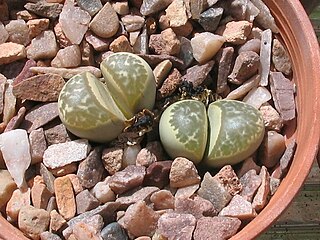
The Aizoaceae, or fig-marigold family, is a large family of dicotyledonous flowering plants containing 135 genera and about 1800 species. Several genera are commonly known as 'ice plants' or 'carpet weeds'. The Aizoaceae are also referred to as vygies in South Africa. Some of the unusual Southern African genera—such as Conophytum, Lithops, Titanopsis and Pleiospilos —resemble gemstones, rocks or pebbles, and are sometimes referred to as 'living stones' or 'mesembs'.

Lithops is a genus of succulent plants in the ice plant family, Aizoaceae. Members of the genus are native to southern Africa. They avoid being eaten by herbivores with their camouflage as small stones, and are often known as pebble plants or living stones.

Lithops aucampiae is a species of flowering plant in the family Aizoaceae, found in South Africa. it was named after Juanita Aucamp, who found a specimen on her father's farm in Postmasburg, Northern Cape in 1929.

Lithops viridis is a species of plant in the family Aizoaceae.

Lithops salicola is a species of perennial plant in the family Aizoaceae, often called living stones, because of its resemblance to round grey pebbles.

Lithops francisci, commonly known as one of the living stones or pebble plants, is in the family Aizoaceae. It is endemic to the arid desert environments of Namibia. It is a succulent with a natural habitat in rocky areas. L. francisci was assessed by Nicholas Edward Brown in 1925. It is one of the Lithops plants and shares the characteristic bi-leaf head pattern separated by a deep fissure, the bottom of which houses and protects the stunted stem.
Gert Cornelius Nel was a South African botanist. His formal botanical author abbreviation is Nel.

Lithops karasmontana, is a species of flowering plant in the ice plant family Aizoaceae, native to Namibia and South Africa.

Lithops lesliei is a species of plant in the family Aizoaceae. The plant is collected for its medicinal properties, and has therefore become threatened.

Lapidaria is a monotypic genus of dwarf succulent plants in the family Aizoaceae. The only species it contains is Lapidaria margaretae, also known as the Karoo rose.

Leaf window, also known as epidermal window, and fenestration, is a specialized leaf structure consisting of a translucent area through which light can enter the interior surfaces of the leaf where photosynthesis can occur. The translucent structure may include epidermal tissue, and in some succulent plants it consists of several cell layers of parenchyma, which may also function as water-storage tissue. It can appear as a large continuous patch, a variegated or reticulated region, or as numerous small spots. It is found in some succulent plants native to arid climates, allowing much of the plant to remain beneath the soil surface where it is protected from desiccation by winds and heat while optimizing light absorption. Many species featuring leaf windows are native to Southern Africa.

Lithops marmorata is a species of succulent pebble plant. It is native to the Northern Cape Province of South Africa. The specific name is derived from the Latin word marmorata meaning "marbled".

Lithops pseudotruncatella is a species of succulent in the family Aizoaceae. Initial confusion associated with Conophytum truncatum is where it derives its name, literally meaning "fake-truncatum". It also received The Royal Horticultural Society's Award of Garden Merit. The plant is endemic to Namibia.

Lithops divergens is a succulent plant species in the genus Lithops of the family Aizoaceae. It is endemic to the western Cape Provinces of South Africa. It is able to withstand intense climatic changes due to its resilience as a succulent. The average annual rainfall for its natural environment is less than 150 mm, occurring primarily in winter which is unusual for a Lithops.

Lithops otzeniana is a species of succulent plant under the genus Lithops. It belongs to the family Aizoaceae. L. otzeniana is native to the Northern Cape province of South Africa. It derives its name from M. Otzen, who invited its discoverer, G.C. Nel, on the trip in which he discovered it.

Lithops meyeri is a species of living stone (Lithops), under the family Aizoaceae. It is native to the Northern Cape province of South Africa. It is named after Rev. Gottlieb Meyer.

Lithops herrei is a species of succulent plant under the genus Lithops and family Aizoaceae. It derives its name from Adolar Herre, a German botanist of the 20th century.

Lithops helmutii is a species of pebble plant. It is native to the northwestern Cape Provinces of South Africa.

Lithops hallii is a species of living stone (Lithops). It is native to the northern Cape Provinces of South Africa. It is a species of the genus Lithops under the family Aizoaceae.

Mesembryanthemum digitatum, or finger-and-thumb plant, is a stemless plant found in South Africa with a clump of 2–4 thick, waxy leaves per shoot that emerge from the ground which resemble human-like fingers.




















